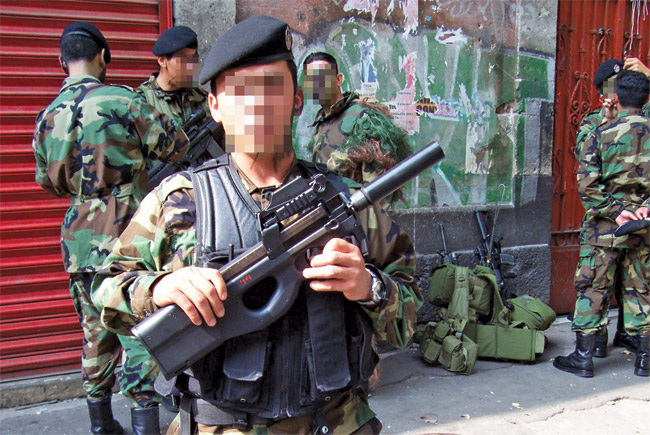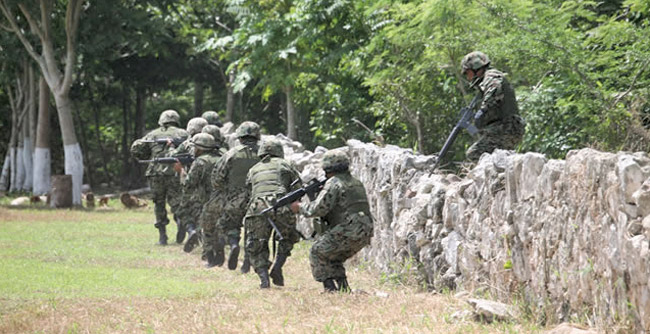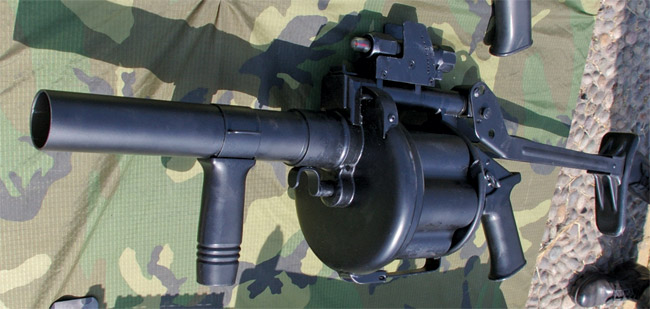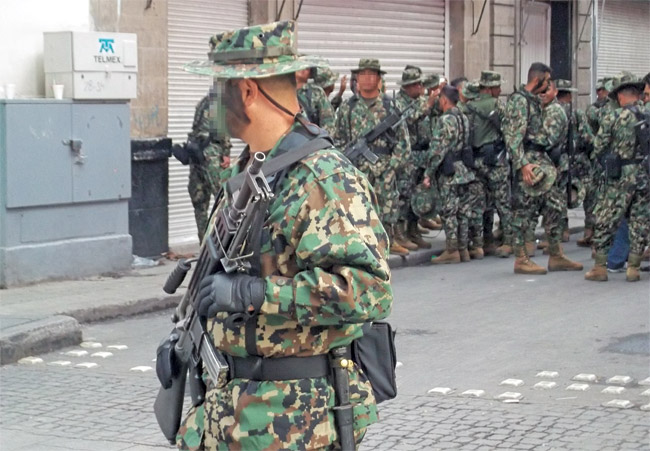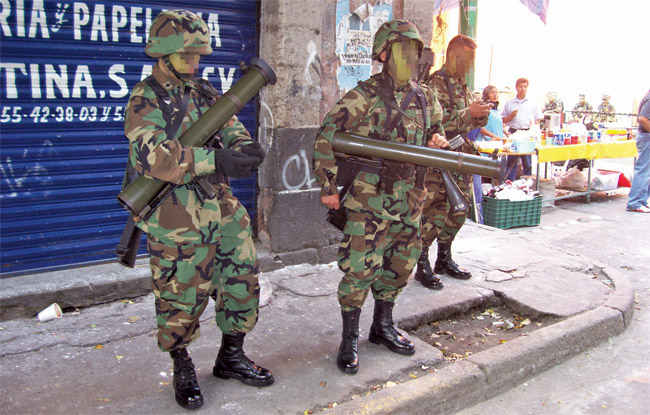Naval Paras and Commandos
Since 2008, naval units have executed the most daring raids against the capos. By 2012, naval intervention units operated mainly along Reynosa, Tamaulipas, and Monterrey (Nuevo León), mounting aggressive operations in Veracruz as well. Always leading the way are the naval special operators, to include commandos from the Gulf FES (FESGO), Pacific FES (FESPA) and the Marine Parachute Fusiliers Battalion (BIMFUSPAR). Their lineage is traced to the organization of the Marine Parachute Brigade in the late 1990s, comprising two Para battalions. By 2001, the Naval Spec Ops were reorganized by breaking up the Naval Parachute Brigade, and leaving a single elite naval battalion (FUSPAR for short), with HQ in the vicinity of Navy HQ, south from Mexico DF. The other Paras formed the core of the new FES (Special Forces – Fuerza, Espíritu y Sabiduría), each deploying 230 operators. A Central FES has been mentioned recently, and implying that responds directly to Naval HQ.
The 7-week basic FES training takes place in the jungles of Chiapas, continuing to courses in CQB, COIN, infiltrations, explosives and demolitions, rappel, and unconventional warfare. Upon completion, the new commandos earn the black beret. Complete training takes up to 53 weeks. Other officers attend special training outside Mexico, and as the Army, naval personnel has attended the 8-week Kaibil Training in Guatemala. By 2005 twelve naval officers had been recorded training in that Central American country. Ten completed the training.
Weapons
There are photos showing Marines practicing with the FX-05 rifle, but at the moment these locally designed and built models are not widely used by the Mexican Naval Riflemen. Instead, the M16A2 and M4/M4A1 variants are issued to front line Marine units, and the Galil is relegated to second line or reserve units.
FAL and G3 rifles are used by support elements, but these are also used by FUSPAR, along with examples of M4 SOPMOD, UMP, and MP-5s. As hundreds of G3s have been remanufactured, there are reports of problems with the rifles jamming in the middle of firefights. Some elite outfits have also been observed carrying the HK G-36. Snipers use the Remington 700 in caliber 7.62 x 51mm, and the Barrett M82A is used as anti-material weapon and long range precision. Other equipment available includes the M-203 grenade launcher and the Milkor MGL, launching 40 x 46mm grenades. The CIS 40 AGL, in 40 x 53mm caliber, provides area support, firing between 350 and 500 rpm.
In the lighter scale, the Marines field the H&K UMP-45, weighting between 2.2 and 3.2 kg (4.8 – 7.0 lb), and firing with a cycle of 600 to 700rpm. The IWI Mini Uzi is also utilized in caliber 9 x 19mm. FES operators have access to the FN P-90, in 5.7 x 28mm caliber. The weapon weighs between 2.5 and 3.0 kg (5.5 – 6.6 lb), and fires at 850 – 900 rpm while being fed by a magazine with 50 cartridges. The Mendoza HMS-3 has also been mentioned within the Naval Infantry arsenal. This is a 9 x 19mm submachine gun developed and built in Mexico. The gun has been recently redesigned, weighing 2.7 kg. The weapon is the brainchild of Héctor Mendoza, and in 1990 it was transformed with the use of polymers, but still using the wrap-around design.
The Marines are said to make use of Daewoo rifles, equipped with drum magazines, but appears to prefer the Colt LMG in the squad firing support role. As Christopher R. Bartocci tells us in an article for Small Arms Defense Journal, Colt’s LMG evolved from a 1970 design. Eventually, the Canadian Diemaco (now Colt Canada) completed the project, redesigned the bipod to have adjustable legs, and adding several design enhancements, placing it into production in the winter of 1987. The M16A2 LMG (R0750) and the similar LSW were made completely in Canada for Diemaco, sold as the LSW, and an updated version available since 2001 as the CAR or Colt Automatic Rifle (R0750MC) is now available from Colt.
The CETME Ameli is another unusual weapon in the hands of the Marines. It is chambered in caliber 5.56 X 45mm, having a weight of 5.3 kg empty and up to 8.3 kg (11.6 – 18.2 Lb) when loaded with links with 100 to 200 rounds. The Ameli fires at 900 rpm. Elite elements also use the FN Minimi in the squad support role, and more recently, Marines have been seen carrying the HK MG-4, an air-cooled belt-fed 5.56mm light machine gun with a locked rotary bolt. It has a folding stock and Mil-Std 1913 Picatinny rail. Heavier support comes from the Mexican made HK 21, in 7.62 x 51mm, some FN-Mag-58s in the same caliber and M2-HB in the classic 12.7 x 99mm. These heavier weapons are usually mounted on vehicles.
The Marines have also incorporated the Infantry Automatic Rifle (IAR6940). Basically, this is an evolution of the mentioned LMG, and also based on the M16/M4 series of rifles. According to Colt, the IAR includes a new “patented Monolithic Upper Receiver with Mil-Std 1913 rails at the 12, 3, and 9 o’clock positions, as well as a lower rail system with a Mil-Std 1913 rail at the 6 o’clock position. In addition, the Colt IAR features a unique heat sink system attached to the barrel, which significantly reduces the risk of cook-offs during extended periods of firing.” The weapon weighs 4.31 kg (9.5 lb), measuring 33.5 in. (85.09 cm) in length with stock retracted, and 36.75 in. (93.35 cm) with stock extended. Its rate of fire is between 700 to 1,000 rpm, and its effective range is rated at 600 m.
Good Neighbors
The Mexican Marines in particular have developed an extremely close relationship with the U.S. Marines in the last few years. Although it is denied that U.S. troops train Mexican counterparts, it is known that Mexican Marines stationed in Colima, Mexico, have trained with U.S. Marines in Military Operations in Urban Terrain (MOUT), and Mexican Marine Cadets have attended OCS in the U.S. The close relationship developed between the two military services in the last few years is undeniable, but would had been unthinkable a couple of decades before. Difficult to forget that, in one of the many U.S. interventions in Mexico, U.S. Marines occupied Veracruz in 1914 after a 6 month battle. This was the aftermath of the Tampico Affair of April 9, 1914, when 9 U.S. sailors were arrested in Tamaulipas, and as consequence, the U.S. Navy received orders to attack Veracruz. On April 21, 502 U.S. Marines from the 2nd Advanced Base Regiment, 285 Navy Bluejackets from the battleship USS Florida and a provisional battalion (with Marines from the Florida and her sister ship USS Utah) began landing operations. They were resisted, between others, by cadets of the Veracruz Naval Academy. All in all, some 94 years later, in September 2005, Mexico dispatched a naval task force to assist the population of New Orleans in the aftermath of Katrina.
The Mexican Marines’ strength in 2012 summed 33 field battalions (30 naval infantry, two HQ, & one presidential), three naval special warfare units (one parachute riflemen battalion and two Special Forces groups), and another 12 Amphibious Infantry, Artillery, Amphibious Commando, Boat and Vehicle and Amphibious and Services Battalions distributed among two Amphibious Marine Reaction Forces.
The new President, Enrique Peña Nieto, will bring changes to the war on drugs. He has reassured that his election does not mean a return of the bad old habits of his party, the PRI, and he is expected to maintain the military on the attack of the drug cartels and organized crime, continuing the drug war. However, he is as likely to shift focus from cross-border drug trafficking to crimes affecting ordinary Mexicans, such as kidnapping, cross fire battles, and others. This certainly means new tasks and mission, and possible a new organization, to the Mexican Marines.




